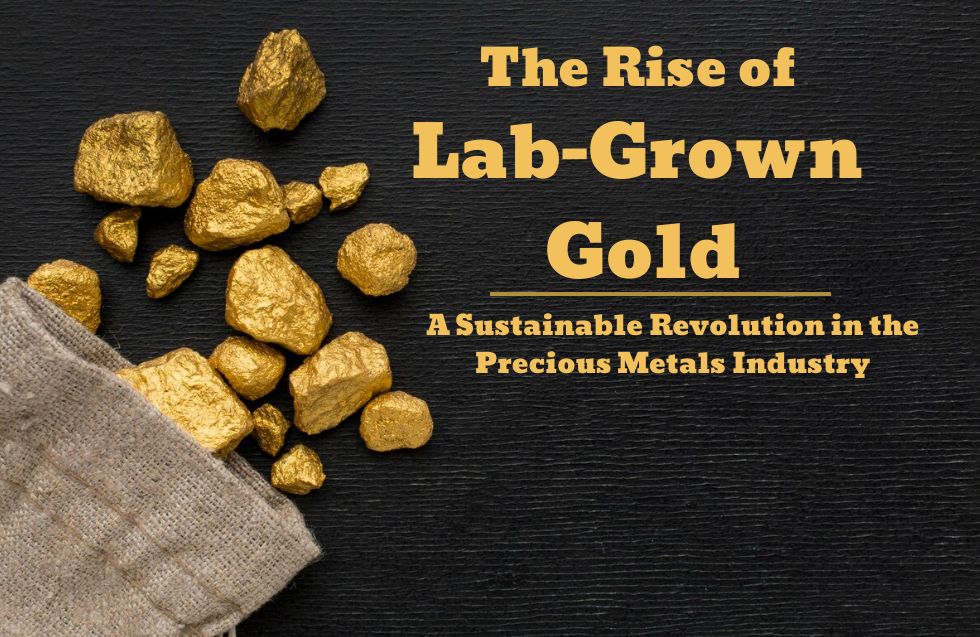Lab-grown gold has historically been honored as one of humanity’s greatest treasures. It represents wealth, beauty, and popularity. Its shine has dazzled us since we’ve lived in caves or built temples, fashioned crowns, created jewelry, or invested wealth in it. And we have been drawn to it for centuries. But while we have admired its glow, most of us have only just begun to feel the weight of the real costs of its existence through both our understanding of the environmental and ethical costs related to traditional mining.
To that end, lab-grown gold is changing the game. It isn’t a sci-fi fantasy or an inexpensive imitation. It is fully produced gold – chemically, physically, and visually the same as the gold mined from the ground – and it is made in laboratories using technology and a much smaller footprint. Lab-grown gold is quietly disrupting the precious metal industry. Let’s first unpack lab-grown gold, why it is important, and how it is reshaping our luxury narrative.
What Is Lab-Grown Gold?
Lab-grown gold (also known as machine-made, cultured, or synthetic gold) is produced in a controlled laboratory setting rather than mined from the ground.
The Lab-grown gold methods generally use sophisticated methods like precipitation from a solution.
Lab-grown gold that is pure, 24-karat, and looks and behaves just like the gold we know — but with no mining.
To put it another way: lab-grown gold is gold. It is not gold plated, not imitation, and not a substitute. It is simply produced more sustainably.
Why Is Lab-Grown Gold So Popular?
We are in a time when conscious consumption is becoming a thing. Consumers particularly millennials and Gen Z – care not only about what they are buying but how it is produced. They seek products that are ethical, transparent and environmentally friendly.
Environmental Impact
Mining gold is one of the most toxic processes to the planet. It entails blowing up mountain tops, using toxic chemicals like cyanide and mercury and displacing ecosystems. Reports suggest that for a single gold ring, a ton of mine waste is produced.
The process of producing lab-grown gold does not rase the earth at all. It utilizes fewer raw materials, produces tons less waste than mining does and does not pollute waterways. It is a big step towards greener jewellery.
Ethical Sourcing
For a long time, the gold mining industry has had associations with human rights violations, unsafe working habits, and in some areas, conflicts. With lab-grown gold, those concerns disappear. No exploitation, no concern over questionable sourcing, no impact on local communities. This allows both brands and buyers to have the assurance that their gold is not at the expense of someone else.
Traceability and Transparency
The public wants to know where their products come from.Traditional gold can have a murky provenance. Lab-grown gold has complete provenance — from production to final polish. This really remains relevant for the high-end jewelry market, where trust and ethics are key.
Is Lab-Grown Gold a Recycled Gold?
Not exactly. Recycled gold, is melted down for old jewellery or electronic, and reused with new jewellery. This is still mined gold, just getting a second life, while better than new bullion gold, recycled gold still carries the original mining footprint.Lab-grown gold is created fresh, and clean with no mining. It’s the only gold that is mine-free available today.
What Does This Mean for the Jewelry Industry?
Lab-grown diamonds are old news. But lab-grown gold is just beginning to make its mark. Major jewelry brands and independent designers are now getting on board, however not simply a fleeting trend, but as a conscientious choice.Jewelry made from lab-grown gold maintains all the beauty, quality, torque, and benevolence of traditional gold. Lab-grown gold can be cast, engraved, polished, enjoyed the same as traditional gold. The difference: there’s no guilt.
Some brands are even now showcasing lab-grown gold as a luxury feature. Some brands are even showcasing this upgrade towards sustainability and values in an item. It is not simply about how something looks anymore, there is a story behind it.
Is Lab-Grown Gold Cheaper?
Yes – frequently it is. Lab-grown gold has a reduced cost since it doesn’t require mining, transportation, and refining. As lab-grown gold can require less production costs, some of those savings may be passed onto consumers increasing the accessibility of fine gold jewelry – without compromising quality
The Future of Lab-Grown Gold
In the future, the rise of lab-grown gold is moving closer and closer to reality. Over the next few years, as technology continues to advance and society continues to embrace it, I predict that we are going to see a sea change in how future generations perceive gold, moving from a mined need into a modern, sustainable alternative.
More and more communicators, from governments and environmental organizations to fashion icons are beginning to realize it. Lab-grown gold is not only a product – it is an entire ethos global shift towards honesty, eco-luxury, and long-term sustainability. Lab-grown gold is not restricted to bits of gold to wear, it can also enter the supply chain for more electronics, into medical devices, and even to where people buy gold bars for investments, and, close the circle of sustainability, would include anything you purchase
Should you choose lab-grown gold?
If you care about the health of the planet, ethical trade, fair supply chains, and conscious living, then lab-grown gold is worth considering. Lab-grown gold can give you the timeless beauty associated with gold, but without all the environmental and human impact.
Maybe it is a gold engagement ring, a pair of gold earrings, or a simple gold chain fabric necklace, there will be a time when you will go lab-grown golds it is not only the right thing to do, it actually does carry some ethical weight. It will be a statement – a statement declaring your values, signalling your awareness, and showcasing the kind of future you want to support.
The Future of Lab-Grown Gold
In the future, the rise of lab-grown gold is moving closer and closer to reality. Over the next few years, as technology continues to advance and society continues to embrace it, I predict that we are going to see a sea change in how future generations perceive gold, moving from a mined need into a modern, sustainable alternative.
More and more communicators, from governments and environmental organizations to fashion icons are beginning to realize it. Lab-grown gold is not only a product – it is an entire ethos global shift towards honesty, eco-luxury, and long-term sustainability.
Lab-grown gold is not restricted to bits of gold to wear, it can also enter the supply chain for more electronics, into medical devices, and even to where people buy gold bars for investments, and, close the circle of sustainability, would include anything you purchase
Conclusion
Lab-grown gold is more than an emerging trend; it truly embodies a transformation of priorities. In a world where sustainability and ethics are no longer negotiable, this approach to gold is changing the traditional narrative.
This only assumes gold is still gold – it’s simply more thought out, smarter, and cleaner. So when you see a gorgeous piece of gold jewelry, ask yourself this: Is it mined or was it produced for a better world?












